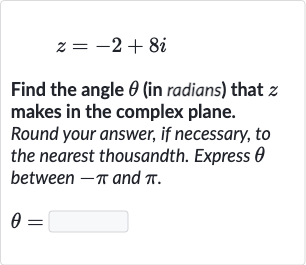Full solution
Q. Find the angle (in radians) that makes in the complex plane. Round your answer, if necessary, to the nearest thousandth. Express between and .
- Identify Real and Imaginary Parts: To find the angle that the complex number makes with the positive real axis in the complex plane, we need to calculate the argument of . The argument of a complex number is the angle formed by the radius (line from the origin to the point) and the positive x-axis. The argument can be found using the function, which is the inverse of the tangent function. The formula to find the argument of a complex number is , where is the real part and is the imaginary part of the complex number.
- Calculate Argument using Arctan: First, we identify the real part and the imaginary part of the complex number . Here, and .
- Determine Quadrant and Adjust Angle: Next, we calculate the argument using the arctan function: . Since the complex number is in the second quadrant (because the real part is negative and the imaginary part is positive), the angle should be in the range .
- Calculate Final Angle: Using a calculator, we find that radians. However, since the angle is in the second quadrant, we need to add to this value to get the angle in the correct range. Therefore, .
- Verify Angle Range: Calculating the value of , we get radians.
- Verify Angle Range: Calculating the value of , we get radians.We check to make sure that our final answer is within the range to . Since is between and , our answer is in the correct range.

